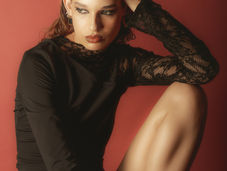Infinite Folds: Barbara Chase-Riboud at the Serpentine Galleries
- Lara Mae Simpson
- Oct 28, 2022
- 4 min read

Face to face with Confessions for Myself (1972), I am mesmerised. A tall, robust structure of patinated black bronze has been welded into uncountable shapes with a heart of wool. The long, charcoal ropes fall through the centre like a spine and drape like a skirt in intricate knots. Somewhere in the bronze I see the outline of a face – a large nose and an eye, half-exposed like a mask, above a vertical rib cage that echoes a claw or scratch. It is an imposing start to Barbara Chase-Riboud’s first UK solo exhibition: Infinite Folds.
Held at the Serpentine North Gallery, the exhibition maps out Chase-Riboud’s stunning seven-decade career, including famous sculptures like her Malcolm X Steles (which span over almost fifty years), drawings and poetry, and her newest work, such as Numero Rouge (2021), a striking piece that echoes the architecture of Beijing’s Forbidden City.
Born in Philadelphia in 1939, the Museum of Modern Art in New York acquired one of her first woodcut prints by the age of sixteen; it is no wonder then that her 2022 memoir is entitled ‘I Always Knew’ as evidently, she was destined for greatness. Chase-Riboud’s worldwide travels and connections to esteemed artists such as Salvador Dalí, James Baldwin, and Toni Morrison have influenced her writing and art. She has since been based in Paris and this year received a Knighthood of the French Légion d’Honneur.
Chase-Riboud’s sculptures are characterised by their juxtapositions: hard, harsh bronze or aluminium and soft, flowing wool or silk. Not only do the soft elements hide the structures’ armatures – ‘the tyranny of the base’, in her words – to create a flowing effect that defies gravity, but the mixing of the ‘skirts’ with the tough materials is a contradiction that refuses any authoritative order. Her sculptures resist rules and hierarchies like a ‘true revolutionary’. For example, her series of sculptures dedicated to Malcolm X after his assassination are large, deep black, and gold, and appear to hover off the ground by their plaited coils whilst the bronze looks shattered like broken glass or wrought with grief. As portraits they are abstract and demand contemplation, requiring you to look closer.

Chase-Riboud’s global inspiration can be seen in the Divine Energies room which displays her work that draws on Chinese and Egyptian influences. Cleopatra’s Wedding Dress (2003) and Cleopatra’s Bed (1997) are made from thousands of bronze squares meticulously sewn onto items of the Egyptian queen, thus exemplifying the power of femininity in these suggestive objects. This is another theme that the artist is interested in: Standing Black Woman / Black Tower (1973) is reminiscent of obelisks and classical architecture, but Chase-Riboud’s monument is a modern remaking, a celebration of Blackness. The Time Womb series (1967-70) also illustrates Chase-Riboud’s feminism: polished aluminium evokes feminine bodies but also hourglasses, with knotted silk spilling out like blood, an umbilical cord, or the sands of time.
Her latest work, La Musica Josephine Red/Black (2021), takes up an entire room and is prefaced by a poem on the wall: ‘From Malcolm to Josephine’. In this, her political engagement connects with her remembering of Malcolm X, Josephine Baker, and her own art manifesto. Chase-Riboud writes that ‘Sculpture must not sit still’, and this is exactly how her work feels; the materials are never static but instead are infinitely folding. They are dancing too, like Josephine Baker, an artist who Chase-Riboud feels she has a ‘parallel existence’ to. Baker was also an American-born, Paris-based Black woman who pioneered in the arts as a performer and etched her name in the cultural history of the city. Chase-Riboud attended Baker’s last performance and her funeral, and her appreciation takes sculpture form in this exhibition. La Musica is a two-metre tall crow-like arm swooping up from the floor and holding stark red coils, draped like a dress you could imagine onstage.

One of my favourite pieces was Bathers (1967), a large square piece of aluminium that resembles an iridescent pool and echoes the colours of Paul Cézanne’s oil painting of the same name. Here the materials are naked: I spent so long admiring textured silver waves, smoothness contrasting with entangled ropes of silk. I also loved Walking Angel (1962) and Adam and Eve (1958). These bronze sculptures reward close attention: the haunting quality of the angel becomes even more apparent when you notice the rugged delicacy of its back, leaning forward from the weight of its small wings held up by frail legs. Adam and Eve are similarly fragile on a garden platform, beneath the tree which is plated with gold leaf on the inside.
At the exhibition’s opening, Chase-Riboud was described as ‘one of the most important and critical contemporary artists’ of our time. Her unique style and extensive career is awe-inspiring, especially when seen in person. Most of the sculptures are taller than anyone – you are literally overcome by her art. Chase-Riboud’s innovative use of contrasting materials, her thought-provoking drawings and her poetry deserve much more recognition. ‘Pioneer’ is not a term to be used lightly but it is necessary – she is a master of modern sculpture-making and is highly worth seeing at the Serpentine Galleries.
Infinite Folds is on at the Serpentine North Gallery until the 29th January 2023 and tickets are available for free here.
Edited by Maisie Allen, Literature Editor
























Comments